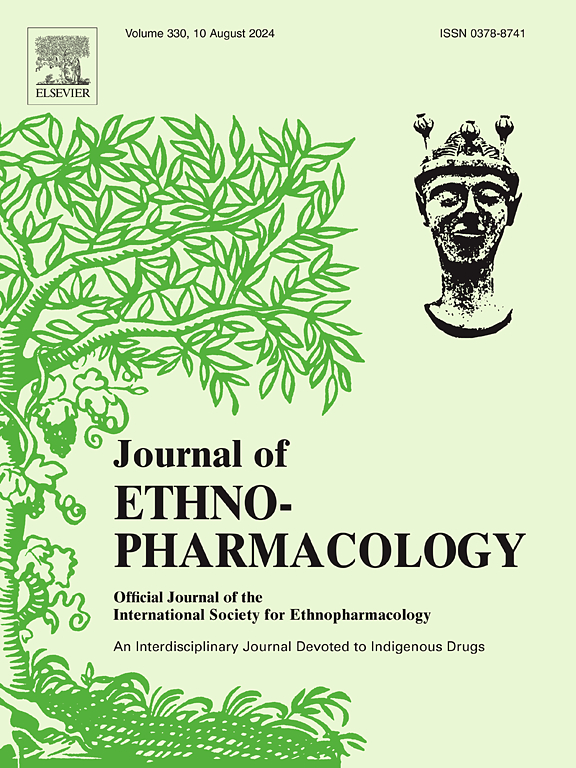Sanleng Wan inhibits endometriosis progression by regulating sphingolipid metabolism via the S1P/S1PR1-Akt axis based on serum metabolomics and network pharmacology
IF 5.4
2区 医学
Q1 CHEMISTRY, MEDICINAL
引用次数: 0
Abstract
Ethnopharmacological relevance
Endometriosis is a gynecological disorder characterized by chronic pelvic pain and infertility in women. The traditional herbal medicine Sanleng Wan (SLW) is composed of Curcuma phaeocaulis Valeton (Chinese name: Ezhu) and Sparganium stoloniferum (Buch.-Ham. ex Graebn.) Buch.-Ham. ex Juz. (Chinese name: Sanleng), has been recognized for its therapeutic potential in managing gynecological conditions, including endometriosis. In numerous traditional Chinese medicine prescriptions, SLW is classified as either the “principal drug” or the “minister drug.” However, the extent to which the therapeutic effects of SLW are mediated through the modulation of serum metabolites and associated molecular targets remains unclear.
Aim of the study
This study aimed to elucidate the potential mechanism by which SLW inhibits endometriosis, utilizing serum metabolomics, network pharmacology, molecular docking, SPR affinity analysis and preliminary in vivo validation.
Materials and methods
A rat model of endometriosis was established using the autotransplantation method. The animals were divided into blank control, model, high-, middle-, and low-dose SLW groups, and the dienogest-treated group as a positive control. SLW or dienogest was administered for 4 weeks. Fibrosis in the lesions was assessed using Masson staining. Serum metabolomics analysis was conducted to investigate the effects of SLW on serum metabolites in endometriosis model rats, and metabolic pathways were analyzed using the MetaboAnalyst database. A metabolites-targets-pathways network was constructed using Cytoscape software. Additionally, surface plasmon resonance (SPR)-based binding affinity analysis was conducted to investigate potential direct interactions between the bioactive compounds and key proteins. Five major principal compounds (zederone, curcumin, ferulic acid, curcumol, and curdione) were evaluated for the binding capabilities with three proteins: sphingosine kinase 2 (SphK2), sphingosine-1-phosphate receptor 1 (S1PR1), and AKT serine/threonine kinase (Akt). Subsequently, the expression levels of transforming growth factor-β (TGF-β), sphingosine-1-phosphate (S1P), S1PR1, SphK2 and Akt, and phosphorylated Akt (p-Akt) in ectopic endometrium tissue were quantified using Western blot analysis.
Results
In a rat model, SLW inhibited the growth of endometriotic lesions and suppressed fibrosis. Metabolomic analysis revealed distinct serum metabolites associated with SLW treatment. A total of 76 significant metabolites were identified in the serum of the SLW-treated group, including L-threonine, (S)-homostachydrine, DL-arginine, and L-homoarginine, among others. These metabolites were involved in various metabolic pathways, including sphingolipid signaling, tyrosine metabolism, fatty acid degradation, arachidonic acid metabolism, pyruvate metabolism, linoleic acid metabolism, and glycerophospholipid catabolism. Molecular docking and SPR affinity analysis demonstrated that compounds including ferulic acid, zederone, curcumin, zedrone, curcumol, and curdione contribute to the modulation of targets within the S1P/S1PR1-Akt signaling axis. Notably, compared with the model endometriosis group, SLW treatment significantly downregulated the protein expression levels of TGF-β, SphK2, S1P, and S1PR1 in ectopic endometrial tissues of rats, while markedly reducing the p-Akt/Akt ratio. These findings shed light on the potential molecular mechanisms underlying SLW's therapeutic effects.
Conclusions
This study, utilizing serum metabolomics and network pharmacology, demonstrates the therapeutic effects of SLW in endometriosis model rats by modulating sphingolipid metabolism via the S1P/S1PR1-Akt axis, thereby enhancing understanding of its underlying mechanisms of action.

基于血清代谢组学和网络药理学,三冷丸通过S1P/S1PR1-Akt轴调控鞘脂代谢,抑制子宫内膜异位症进展。
民族药理学相关性:子宫内膜异位症是一种以女性慢性盆腔疼痛和不孕为特征的妇科疾病。传统中药三冷丸由姜黄(中国名:莪术)和白藜芦醇(bugganium stoloniferum)组成。Graebn交货)。Buch.-Ham。前想你。(中文名:三棱),因其治疗妇科疾病的潜力而得到认可,包括子宫内膜异位症。在众多中医处方中,SLW被归类为“主药”或“臣药”。然而,SLW的治疗效果在多大程度上是通过调节血清代谢物和相关分子靶点介导的,目前尚不清楚。研究目的:本研究旨在通过血清代谢组学、网络药理学、分子对接、SPR亲和分析和初步体内验证,阐明SLW抑制子宫内膜异位症的潜在机制。材料与方法:采用自体子宫内膜移植法建立大鼠子宫内膜异位症模型。将大鼠分为空白对照、模型组、高、中、低剂量组,并以糖甙处理组为对照。使用SLW或dienogest治疗4周。马松染色法评估病变纤维化程度。采用血清代谢组学分析研究SLW对子宫内膜异位症模型大鼠血清代谢物的影响,并利用MetaboAnalyst数据库分析代谢途径。利用Cytoscape软件构建代谢物-靶标-通路网络。此外,为了研究生物活性化合物与关键蛋白之间潜在的直接相互作用,我们进行了基于表面等离子体共振(SPR)的结合亲和力分析。五种主要化合物(莪术酮、姜黄素、阿魏酸、姜黄酚和莪术酮)与三种蛋白的结合能力进行了评估:鞘氨醇激酶2 (SphK2)、鞘氨醇-1-磷酸受体1 (S1PR1)和AKT丝氨酸/苏氨酸激酶(AKT)。Western blot检测异位子宫内膜组织中转化生长因子-β (TGF-β)、鞘鞘醇-1-磷酸(S1P)、S1PR1、SphK2、Akt及磷酸化Akt (p-Akt)的表达水平。结果:在大鼠模型中,SLW抑制子宫内膜异位症病变的生长,抑制纤维化。代谢组学分析显示与SLW治疗相关的不同血清代谢物。在slw处理组的血清中共鉴定出76种显著代谢物,包括l -苏氨酸、(S)-高精氨酸、dl -精氨酸和l -同型精氨酸等。这些代谢物参与多种代谢途径,包括鞘脂信号传导、酪氨酸代谢、脂肪酸降解、花生四烯酸代谢、丙酮酸代谢、亚油酸代谢和甘油磷脂分解代谢。分子对接和SPR亲和分析表明,阿魏酸、莪术酮、姜黄素、莪术酮、莪术酚和莪术酮等化合物参与了S1P/S1PR1-Akt信号轴内靶点的调节。值得注意的是,与模型子宫内膜异位症组相比,SLW治疗显著下调异位子宫内膜组织中TGF-β、SphK2、S1P、S1PR1蛋白表达水平,同时显著降低p-Akt/Akt比值。这些发现揭示了SLW治疗作用的潜在分子机制。结论:本研究利用血清代谢组学和网络药理学,证明了SLW通过S1P/S1PR1-Akt轴调节鞘脂代谢对子宫内膜异位症模型大鼠的治疗作用,从而加深了对其作用机制的理解。
本文章由计算机程序翻译,如有差异,请以英文原文为准。
求助全文
约1分钟内获得全文
求助全文
来源期刊

Journal of ethnopharmacology
医学-全科医学与补充医学
CiteScore
10.30
自引率
5.60%
发文量
967
审稿时长
77 days
期刊介绍:
The Journal of Ethnopharmacology is dedicated to the exchange of information and understandings about people''s use of plants, fungi, animals, microorganisms and minerals and their biological and pharmacological effects based on the principles established through international conventions. Early people confronted with illness and disease, discovered a wealth of useful therapeutic agents in the plant and animal kingdoms. The empirical knowledge of these medicinal substances and their toxic potential was passed on by oral tradition and sometimes recorded in herbals and other texts on materia medica. Many valuable drugs of today (e.g., atropine, ephedrine, tubocurarine, digoxin, reserpine) came into use through the study of indigenous remedies. Chemists continue to use plant-derived drugs (e.g., morphine, taxol, physostigmine, quinidine, emetine) as prototypes in their attempts to develop more effective and less toxic medicinals.
 求助内容:
求助内容: 应助结果提醒方式:
应助结果提醒方式:


